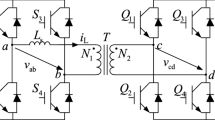Abstract
In order to solve the problems such as high backflow power and current stress of bidirectional DC–DC converter under the traditional single phase-shifting control, an optimized dual phase-shifting control method is proposed. Compared with the conventional phase-shifting control, this method can not only reduce the loss of the converter but also increase the flexibility of the control and realize full voltage range transmission. Firstly, the working principle of dual phase-shifting control and the mathematical model of backflow power are analyzed in detail. Then, the different operating range of return power according to the range of transmission power and voltage transformation ratio are derived. So as to achieve the goal of optimal operation of return power in full mode, the optimal solution of local return power and the corresponding combination of phase-shifting angle are found out. Finally, the superiorities of the control strategy are verified by the experimental results.









Similar content being viewed by others
References
An F, Song W, Yang K (2018) Optimised power control with extended phase shift in dual-active-bridge DC–DC converters. Electron Lett 54(10):651–653
Bai H, Mi C (2008) Eliminate reactive power and increase system efficiency of isolated bidirectional dual-active-bridge DC–DC converters using novel dual-phase-shift control. IEEE Trans Power Electron 23(6):2905–2914
Bhushan K, Gupta BB (2018) Network flow analysis for detection and mitigation of Fraudulent Resource Consumption (FRC) attacks in multimedia cloud computing. Multimed Tools Appl 78(4):4267–4298
Chang X, Yang Y (2017) Semisupervised feature analysis by mining correlations among multiple tasks. IEEE Trans Neural Netw Learn Syst 28(10):2294–2305
Chang X, Ma Z, Lin M, Yang Y, Hauptmann AG (2017a) Feature interaction augmented sparse learning for fast kinect motion detection. IEEE Trans Image Process 26(8):3911–3920
Chang X, Yu Y, Yang Y, Xing EP (2017b) Semantic pooling for complex event analysis in untrimmed videos. IEEE Trans Pattern Anal Mach Intell 39(8):1617–1632
Chang X, Ma Z, Yang Y, Zeng Z, Hauptmann AG (2017c) Bi-level semantic representation analysis for multimedia event detection. IEEE Trans Cybern 47(5):1180–1197
Engel SP, Soltau N, Stagge H, De Doncker RW (2013) Dynamic and balanced control of three-phase high-power dual-active bridge DC–DC converters in DC-grid applications. IEEE Trans Power Electron 28(4):1880–1889
Fan H, Li H (2010) A novel phase-shift bidirectional DC–DC converter with an extended high-efficiency range for 20 kVA solid-state transformer. In: 2010 IEEE energy conversion congress and exposition, Atlanta, GA, pp 3870–3876
Huang J, Wang Y, Li Z, Lei W (2016) Unified triple-phase-shift control to minimize current stress and achieve full soft-switching of Isolated Bidirectional DC–DC converter. IEEE Trans Ind Electron 63(7):4169–4179
Kim M, Rosekeit M, Sul S, De Doncker RWAA (2011) A dual-phase-shift control strategy for dual-active-bridge DC–DC converter in wide voltage range. In: 8th International conference on power electronics—ECCE Asia, Jeju, pp 364–371
Kumar A, Bhat AH, Agarwal P (2017) Comparative analysis of dual active bridge isolated DC to DC converter with single-phase shift and extended phase shift control techniques. In: 2017 6th International conference on computer applications in electrical engineering-recent advances (CERA), Roorkee, pp 397–402
Li Z, Nie F, Chang X, Yang Y (2017) Beyond trace ratio: weighted harmonic mean of trace ratios for multiclass discriminant analysis. IEEE Trans Knowl Data Eng 29(10):2100–2110
Mi C, Bai H, Wang C, Gargies S (2008) Operation, design, and control of dual H-bridge-based isolated bidirectional DC–DC converter. IET Power Electron 1(4):507–517
Muthuraj SS, Kanakesh VK, Das P, Panda SK (2017) Triple phase shift control of an LLL tank based bidirectional dual active bridge converter. IEEE Trans Power Electron 32(10):8035–8053
Shi H et al (2018) Minimum-backflow-power scheme of DAB-based solid-state transformer with extended-phase-shift control. IEEE Trans Ind Appl 54(4):3483–3496
Wang C, Sha G, Cheng H, Deng Q (2016) Unified phasor analytical method for dual-active-bridge DC–DC converter under phase-shift control. In: 2016 IEEE 8th International power electronics and motion control conference (IPEMC-ECCE Asia), Hefei, pp 348–355
Wen H, Chen J (2016) Control and efficiency optimization of dual-active-bridge DC–DC converter. In: 2016 IEEE International conference on power electronics, drives and energy systems (PEDES), Trivandrum, pp 1–6
Wen H, Su B (2015) Reactive power and soft-switching capability analysis of dual-active-bridge DC–DC converters with dual-phase-shift control. J Power Electron 15(15):18–30
Wen H, Su B, Xiao W (2013) Design and performance evaluation of a bidirectional isolated DC–DC converter with extended dual-phase shift scheme. IET Power Electron 6(5):914–924
Xu CD, Cheng KWE (2011) A survey of distributed power system DC–DC AC versus DC distributed power system. In: 2011 4th International conference on power electronics systems and applications, Hong Kong, 2011, pp 1–12
Zhao B, Yu Q, Sun W (2012a) Extended-phase-shift control of Isolated Bidirectional DC–DC converter for power distribution in Microgrid. IEEE Trans Power Electron 27(11):4667–4680
Zhao B, Song Q, Liu W (2012b) Power characterization of isolated bidirectional dual-active-bridge DC–DC converter with dual-phase-shift control. IEEE Trans Power Electron 27(9):4172–4176
Zhao B, Song Q, Liu W, Sun W (2013) Current-stress-optimized switching strategy of isolated bidirectional DC–DC converter with dual-phase-shift control. IEEE Trans Ind Electron 60(10):4458–4467
Acknowledgement
This work was supported by the National Natural Science Foundation of China under Grant 51607064 and 51807058 and Natural Science Foundation of Hunan Province under Grant 2018JJ3129.
Author information
Authors and Affiliations
Corresponding author
Ethics declarations
Conflict of interest
The authors declare no conflict of interest.
Additional information
Communicated by B. B. Gupta.
Publisher's Note
Springer Nature remains neutral with regard to jurisdictional claims in published maps and institutional affiliations.
Rights and permissions
About this article
Cite this article
Zeng, J., He, Y., Lan, Z. et al. Optimal control of DAB converter backflow power based on phase-shifting strategy. Soft Comput 24, 6031–6038 (2020). https://doi.org/10.1007/s00500-020-04715-z
Published:
Issue Date:
DOI: https://doi.org/10.1007/s00500-020-04715-z




